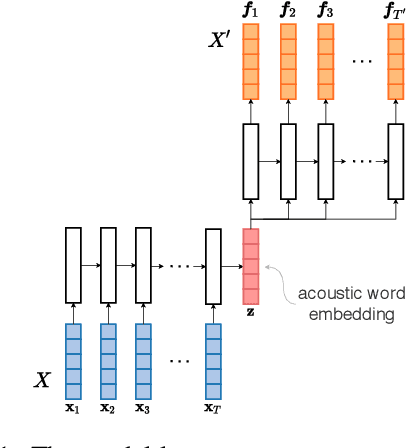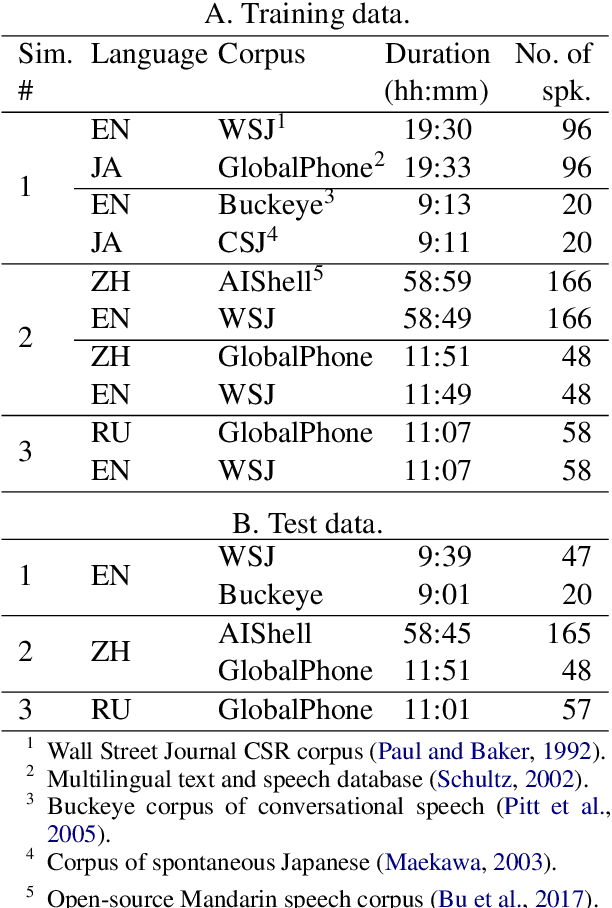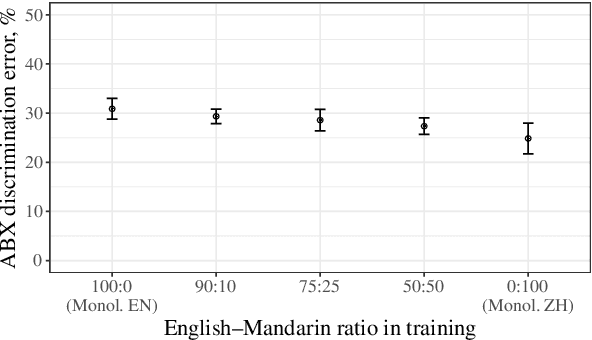Thomas Schatz
Simulating Articulatory Trajectories with Phonological Feature Interpolation
Aug 08, 2024



Abstract:As a first step towards a complete computational model of speech learning involving perception-production loops, we investigate the forward mapping between pseudo-motor commands and articulatory trajectories. Two phonological feature sets, based respectively on generative and articulatory phonology, are used to encode a phonetic target sequence. Different interpolation techniques are compared to generate smooth trajectories in these feature spaces, with a potential optimisation of the target value and timing to capture co-articulation effects. We report the Pearson correlation between a linear projection of the generated trajectories and articulatory data derived from a multi-speaker dataset of electromagnetic articulography (EMA) recordings. A correlation of 0.67 is obtained with an extended feature set based on generative phonology and a linear interpolation technique. We discuss the implications of our results for our understanding of the dynamics of biological motion.
A phonetic model of non-native spoken word processing
Jan 27, 2021



Abstract:Non-native speakers show difficulties with spoken word processing. Many studies attribute these difficulties to imprecise phonological encoding of words in the lexical memory. We test an alternative hypothesis: that some of these difficulties can arise from the non-native speakers' phonetic perception. We train a computational model of phonetic learning, which has no access to phonology, on either one or two languages. We first show that the model exhibits predictable behaviors on phone-level and word-level discrimination tasks. We then test the model on a spoken word processing task, showing that phonology may not be necessary to explain some of the word processing effects observed in non-native speakers. We run an additional analysis of the model's lexical representation space, showing that the two training languages are not fully separated in that space, similarly to the languages of a bilingual human speaker.
Evaluating computational models of infant phonetic learning across languages
Aug 06, 2020



Abstract:In the first year of life, infants' speech perception becomes attuned to the sounds of their native language. Many accounts of this early phonetic learning exist, but computational models predicting the attunement patterns observed in infants from the speech input they hear have been lacking. A recent study presented the first such model, drawing on algorithms proposed for unsupervised learning from naturalistic speech, and tested it on a single phone contrast. Here we study five such algorithms, selected for their potential cognitive relevance. We simulate phonetic learning with each algorithm and perform tests on three phone contrasts from different languages, comparing the results to infants' discrimination patterns. The five models display varying degrees of agreement with empirical observations, showing that our approach can help decide between candidate mechanisms for early phonetic learning, and providing insight into which aspects of the models are critical for capturing infants' perceptual development.
* 7 pages, 1 figure
Sampling strategies in Siamese Networks for unsupervised speech representation learning
Aug 23, 2018



Abstract:Recent studies have investigated siamese network architectures for learning invariant speech representations using same-different side information at the word level. Here we investigate systematically an often ignored component of siamese networks: the sampling procedure (how pairs of same vs. different tokens are selected). We show that sampling strategies taking into account Zipf's Law, the distribution of speakers and the proportions of same and different pairs of words significantly impact the performance of the network. In particular, we show that word frequency compression improves learning across a large range of variations in number of training pairs. This effect does not apply to the same extent to the fully unsupervised setting, where the pairs of same-different words are obtained by spoken term discovery. We apply these results to pairs of words discovered using an unsupervised algorithm and show an improvement on state-of-the-art in unsupervised representation learning using siamese networks.
Learning Filterbanks from Raw Speech for Phone Recognition
Apr 04, 2018



Abstract:We train a bank of complex filters that operates on the raw waveform and is fed into a convolutional neural network for end-to-end phone recognition. These time-domain filterbanks (TD-filterbanks) are initialized as an approximation of mel-filterbanks, and then fine-tuned jointly with the remaining convolutional architecture. We perform phone recognition experiments on TIMIT and show that for several architectures, models trained on TD-filterbanks consistently outperform their counterparts trained on comparable mel-filterbanks. We get our best performance by learning all front-end steps, from pre-emphasis up to averaging. Finally, we observe that the filters at convergence have an asymmetric impulse response, and that some of them remain almost analytic.
 Add to Chrome
Add to Chrome Add to Firefox
Add to Firefox Add to Edge
Add to Edge